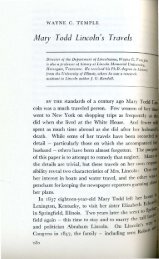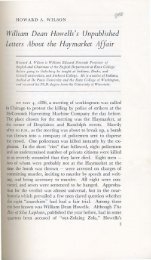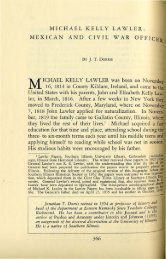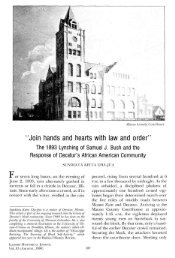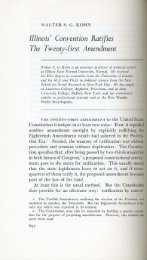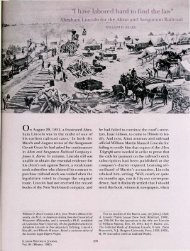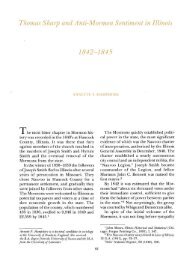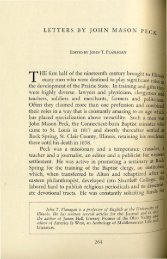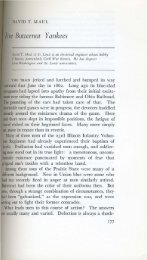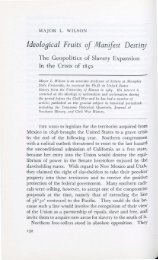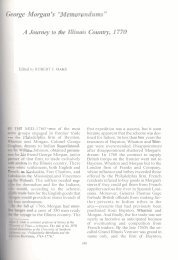Cairo's Civil War Ansel, Mary Jane Safford
Cairo's Civil War Ansel, Mary Jane Safford
Cairo's Civil War Ansel, Mary Jane Safford
You also want an ePaper? Increase the reach of your titles
YUMPU automatically turns print PDFs into web optimized ePapers that Google loves.
LE ROY H. FISCHER<br />
<strong>Cairo's</strong> <strong>Civil</strong> <strong>War</strong> <strong>Ansel</strong>,<br />
<strong>Mary</strong> <strong>Jane</strong> <strong>Safford</strong><br />
LeRoy H. Fischer is a professor of history at Oklahoma State<br />
University, Stillwater, where he has been teaching for the<br />
past fifteen years. H e is a native of Hoffman, Illinois<br />
(seven miles west of Centralia) , and received his Ph.D. from<br />
the University of Illinois in 1943. A m ember of the<br />
Oklahoma <strong>Civil</strong> <strong>War</strong> Centennial Commission, he has had<br />
articles published in several historical periodicals. This<br />
article is an outgro wth of research on a <strong>Mary</strong> <strong>Jane</strong> <strong>Safford</strong><br />
biography for the three-volume work Notable American Women,<br />
1607-1950, to be issued by the Belknap Press of Harvm'd<br />
University Press.<br />
THE CIVIL WAR came to Cairo, Illinois, in April, 186 I,<br />
the opening month of that conflict. This southernmost city<br />
in the Union sprang into importance because of its strategic<br />
location at the confluence of the Ohio and Mississippi rivers<br />
and was soon a huge military encampment. Thousands of<br />
troops were housed in tents and barrack-type sheds along<br />
unimproved streets that often became bottomless quagmires.<br />
Sanitation facilities were practically unknown, and before<br />
long the fever-ridden camp sites held vast numbers of sick<br />
soldiers for whom improvised hospitals could provide only<br />
the crudest care. Beds, made of cornhusks or straw, had<br />
no sheets and were laid on the bare ground. Medicine and<br />
hospital supplies were scarce, and some of the so-called doctors<br />
were untrained. Nurses were usually convalescent<br />
soldiers, and generally unsatisfactory. Trained male nurses,<br />
229
CAIRO'S CIVIL WAR ANGEL<br />
the only ones authorized by army regulations, were<br />
unavailable. The food was the same unpalatable fare<br />
pared by the men on active duty, and was served on<br />
tin plates. Throughout the wards filth predominated, and<br />
the unbathed patients had nothing to wear but their dirty<br />
underclothing. The pungent smell of the sick, of grimy<br />
bodies, excrement, and stale food, was all but overpowering.<br />
Death came day after day from dysentery, pneumonia, and<br />
typhoid, largely because of unsanitary conditions, medical<br />
lethargy, or incompetence. 1<br />
When news of the deplorable conditions in the<br />
of Cairo reached Galesburg, Illinois, the members of<br />
Brick Congregational Church under the leadership of<br />
Edward Beecher (brother of the abolitionist preacher<br />
<strong>War</strong>d Beecher) decided to act.<br />
hundred men in the Cairo camps had already died of<br />
ease. Medical and hospital supplies were gathered<br />
gether, and Mrs. <strong>Mary</strong> Ann Bickerdyke, a "botanic<br />
cian" with four years of training at Oberlin College<br />
experienced in hospital nursing, was persuaded to<br />
pany them to Cairo and see to their use. Recently<br />
and the mother of two small sons, Mrs. Bickerdyke at<br />
four was vigorous, brusque, and capable. A person<br />
hardy could not have survived the unhealthful<br />
or overcome the army regulations, which at the time<br />
hibited the employment of female nurses. 2<br />
I. The preceding paragraph is a composite of materials in<br />
Lansden, A History of the City of Cairo, Illinois (Chicago, 19IO<br />
Arthur Charles Cole, The Era of the <strong>Civil</strong> <strong>War</strong>, 1848-1870 (The<br />
History of Illinois, III, Springfield, 1919), 351-53; Anthony Trollope,<br />
America (New York, 1862), 402-6; Agatha Young, The Women<br />
Crisis: Women of the North in the <strong>Civil</strong> <strong>War</strong> (New York, 1959),<br />
2. Nina Brown Baker, Cyclone in Calico: The Story of <strong>Mary</strong> Ann<br />
dyke (Boston, 1952), 3-11.<br />
23°
Mrs. <strong>Mary</strong> A. "Mother" Bickerdyke.<br />
Mrs. Bickerdyke reached Cairo in June, 186 I, but a remarkable<br />
young lady, a Cairo resident, had been assisting<br />
daily in the town's military hospitals since they had been<br />
opened more than two months earlier. Her name was <strong>Mary</strong><br />
<strong>Jane</strong> <strong>Safford</strong>, and she probably was the first woman in the<br />
West to carryon military hospital relief. The two women<br />
were different, yet alike. Bickerdyke was large, heavy, with<br />
'muscles of iron and nerves of steel," a dynamic personality.<br />
<strong>Safford</strong> was small, frail, refined, retiring, beautiful, and<br />
sweetly romantic. Both were patriotic, dedicated, sensitive,<br />
self-reliant, kind, tender, unselfish, educated, and proficient.<br />
With a common purpose the two women began working together,<br />
and a relationship developed that was undoubtedly<br />
a most important influence in <strong>Mary</strong> <strong>Safford</strong>'s life. 3<br />
<strong>Mary</strong> had been born twenty-six years before in the tiny<br />
Vermont village of Hyde Park, the youngest of five children.<br />
She was descended from Thomas <strong>Safford</strong>, who had emigrated<br />
from England in 1630 and was a founder of the Mas<br />
sachusetts Bay Colony. When she was three, her family<br />
3. Ibid., 37-45, 5 1-52; Young, Women and the Crisis, 93-94; Dictionary<br />
of American Biography, II: 237-38.
CAIRO'S CIVIL WAR ANGEL<br />
moved to Crete, near Chicago, where her parents had bought<br />
a farm. Her father died in 1848, and a year later, following<br />
the death of her mother, <strong>Mary</strong> attended school at Bakersfield,<br />
Vermont. After her graduation she spent a year<br />
studying French near Montreal, then lived in the family<br />
of an educated German for the purpose of learning<br />
language. Returning to Illinois, she resided in Joliet, where<br />
a brother, Alfred Boardman <strong>Safford</strong>, twelve years her<br />
ior, was in the mercantile business. She soon moved<br />
him to Shawneetown, where she established a school,<br />
her brother advancing the money for the building.<br />
moved, in 1858, again with her brother, to Cairo, where<br />
became a wealthy banker and community benefactor. 4<br />
The outbreak of the <strong>Civil</strong> <strong>War</strong> and the urgent need<br />
hospital relief in Cairo brought <strong>Mary</strong> a new<br />
for usefulness. Caring for the sick was something of a<br />
tradition, since, as a child, she had been impressed by<br />
demands made upon her mother to attend their ill<br />
in northern Illinois." This background prompted in<br />
a desire to comfort the patients by reading them<br />
passages from the Bible. The image of the ministering<br />
of the sick, as portrayed in the poetry and fiction of the<br />
was a role that many a well-intentioned girl hoped to<br />
In the East the military hospitals were suffering<br />
veritable plague of this highly impractical type of<br />
help. Cairo, much smaller, had but one angel, and<br />
4. The family genealogy is in Edward S. <strong>Safford</strong>, comp., "The<br />
in America" (typewritten MS, r923, in Library of Congress).<br />
materials are in William H enry Perrin, ed., History of Alexander,<br />
Pulaski Counties, Illinois (Chicago, r883), 56A-56E, and Egbert<br />
Biographical Cyclopaedia of Homeopathic Physicians and Surgeons<br />
delphia, r873), 466.<br />
5. Ibid.; Elizabeth B. Sammons, "<strong>Mary</strong> J. <strong>Safford</strong>, M. D.," T<br />
(June, r894): 261.<br />
232
LE ROY H . FISCHER<br />
was just at the threshold of her celestial career when <strong>Mary</strong><br />
Ann Bickerdyke caught her and brought her down to earth.""<br />
<strong>Mary</strong> was given a tour of the tent-and-shed hospitals by<br />
Mrs. Bickerdyke, who pointed out exactly what needed<br />
doing and emphasized the hard, unglamorous, and often<br />
repulsive labors required to complete the task. After <strong>Mary</strong><br />
had recovered from the initial shock, she set aside the inhibitions<br />
and artificialities of social tradition and settled<br />
down to a routine of daily work under the direction of Mrs.<br />
Bickerdyke. The older woman - by then known to all the<br />
patients as "Mother" - spared her the worst of the work,<br />
and did the quantity cooking and the washing of clothing<br />
and bedding. <strong>Mary</strong>'s tasks were lighter and included<br />
changing bed linens, spoon-feeding the very ill, reading<br />
and writing letters for the illiterate or the unable.<br />
work was pleasant only by comparison with Mrs.<br />
for there was no escaping the heat, the cold,<br />
flies, and the overpowering smells. But the two women<br />
wholly co-operative, complementing each other's efand<br />
bringing a commendable degree of cleanliness,<br />
,mtOift hope, and cheer where there had been nothing but<br />
and squalid misery. <strong>Mary</strong> admired Mrs. Bickerlooked<br />
up to her as an ideal, and tried to imitate her.<br />
services, like those of Mrs. Bickerdyke, were un<br />
She was a civilian volunteer, like Clara Barton, Helen<br />
and Cornelia Hancock, and was never enrolled in<br />
Army Nursing Corps superintended by Dorothea L.<br />
the occasional opposition of surgeons and officers<br />
of the Cairo hospitals, <strong>Mary</strong>, like Mother Bicker<br />
Baker, Cyclone in Calico, 51-52.<br />
Ibid.; Young, Women and the Crisis, 98-99; <strong>Mary</strong> J. <strong>Safford</strong> to Frank<br />
Cairo, Ill., Dec. 28, 1866, in New York Historical Society.<br />
233
CAIRO'S CIVIL WAR ANGEL<br />
dyke, did as she pleased. On her daily visits she carried a<br />
memorandum book in one hand and a large basket of delicacies<br />
in the other, while a porter followed with an even<br />
larger basket. <strong>Mary</strong> personally prepared sick-diet foods authorized<br />
by the patients' physicians, and labeled them with<br />
the name of the hospital and the number of the ward and<br />
bed. In addition to food, she supplied handiwork items,<br />
magazines, newspapers, games, and letter-writing materials.<br />
Many of these were purchased with money donated by her<br />
brother, although she requisitioned and drew regularly upon<br />
supplies shipped to Cairo from the Chicago office of the<br />
United States Sanitary Commission, the forerunner of<br />
American Red Cross.8<br />
Early in th.: war an observer writing for a Chicago<br />
paper graphically told of <strong>Mary</strong>'s contribution to the<br />
of <strong>Cairo's</strong> hospitals:<br />
I cannot close this letter from Cairo without a passing word<br />
one whose name is mentioned by thousands of our soldiers<br />
gratitude and blessing. Miss <strong>Mary</strong> <strong>Safford</strong> is ... devoted to<br />
amelioration of the soldier's lot, and his comfort in the hospitals ..<br />
Her sweet, young face, full of benevolence, pleasant voice, and<br />
ning manner instate her in everyone's heart. , ..<br />
Every sick and wounded soldier in Cairo knows and loves<br />
and as she enters the ward, every pale face brightens at her<br />
proach. As she passes along, she inquires of each one how he<br />
passed the night, if he is well supplied with reading matter,<br />
if there is anything she can do for him. All tell her their<br />
frankly - the man old enough to be her father, and the boy<br />
fifteen, who should be out of the army, and home with his<br />
One thinks he would like a baked apple if the doctor will<br />
it - another a rice pudding, such as she can make - a<br />
8. L. P. Brockett and <strong>Mary</strong> C. Vaughan, Woman's Work in the <strong>Civil</strong><br />
A R ecord of H eroism, Patriotism and Patience (Philadelphia, 1867),<br />
<strong>Mary</strong> A. Livermore, My Story of the <strong>War</strong>: A Woman's Narrative<br />
Years Personal Experience (Hartford, 1888), 206-9; S. Emma E.<br />
Nurse and Spy in the Union Army (Hartford, 1865 ),360-62.<br />
234
LE ROY H . FISCHER<br />
tumbler of buttermilk - a fourth wishes nothing, is discouraged,<br />
thinks he shall die, and breaks down utterly, in tears, and him she<br />
soothes and encourages, till he resolves for her sake, to keep up<br />
a good heart, and hold on to life a little longer - a fifth wants her<br />
to write to his wife - a sixth is afraid to die, and with him, and for<br />
him, her devout spirit wrestles, till light shines through the dark<br />
valley - a seventh desires her to sit by him and read, and so on.<br />
Every request is attended to, be it ever so trivial. . .. She is performing<br />
a noble work . . . in the quietest and most unconscious<br />
manner. 9<br />
Mrs. <strong>Mary</strong> A. Livermore, an organizer and field inspector<br />
for the Northwestern (Chicago) Branch of the United<br />
States Sanitary Commission, was similarly impressed by<br />
<strong>Mary</strong>'s accomplishments in working with the patients of<br />
<strong>Cairo's</strong> hospitals:<br />
The effect of her presence was magical. It was like a breath<br />
of spring borne into the bare, white-washed rooms - like a burst<br />
of sunlight. Every face brightened, and every man who was able,<br />
half raised himself from his bed or chair, as in homage, or expectation.<br />
It would be difficult to imagine a more cheery vision than<br />
her kindly presence, or a sweeter sound than her educated, tender<br />
voice, as she moved from bed to bed, speaking to each one. Now<br />
she addressed one in German, a blue-eyed boy from Holland -<br />
and then she chattered in French to another, made superlatively<br />
happy by being addressed in his native tongue. 10<br />
At no time did <strong>Mary</strong> happen into a more dramatic and<br />
touching hospital situation than when she accompanied Mrs.<br />
Livermore on a tour of inspection for the Sanitary CommiSSIOn.<br />
As they entered one of the wards, a tall, welldressed<br />
officer was being brought in on a stretcher, shot in<br />
the left side the night before on one of the gunboats at<br />
Island Number Ten. After he had been placed on a bed,<br />
9. Quoted in Brockett and Vaughan, Woman's Work in the <strong>Civil</strong> <strong>War</strong>,<br />
360-61; a less complete and less reliable version of this letter is in Edmonds,<br />
Nurse and Spy, 360-62.<br />
10. Livermore, lVly Story of the <strong>War</strong>, 207.<br />
235
Photo courtesy Captain W. H. Trippitt, Hernando, Mississippi<br />
The City of Memphis of the Memphis & St. Louis Packet Co. was tied up<br />
at the bank of the Ohio River just above Fourteenth Street in Cairo when<br />
this picture was taken in 1864. Note the two incline cars at the left which<br />
were used for carrying fr eight ( and possibly wounded soldiers, also) from<br />
the boats up to warehouses on the bank.<br />
taken care of here a heap better than I was in Cairo; but<br />
I'd rather be there than here, for the sake of seeing that<br />
little gal that used to come in every day to see us. I tell<br />
you what, she's an angel, if there is any.1l13 On Christmas<br />
Day, r861, at a time when there were approximately twentyfive<br />
regiments quartered in Cairo, <strong>Mary</strong> visited all the hospital<br />
tents and wards and gave each sick soldier a small<br />
but useful present. 14 Mother Bickerdyke may have caused<br />
<strong>Mary</strong> to become somewhat more practical in her hospital<br />
visits, but even the lady from Galesburg recognized the need<br />
for this type of nursing assistance, and wholly approved of<br />
the angel reputation the Cairo belle was developing.<br />
13. Quoted in Brockett and Vaughan, Woman's Work in the <strong>Civil</strong> <strong>War</strong>,<br />
361.<br />
14· Ibid., 358.<br />
237
CAIRO>S CIVIL WAR ANGEL<br />
Another aspect of <strong>Mary</strong>'s service, however, was probably<br />
more appreciated by Mrs. Bickerdyke. When action nine·<br />
teen miles distant at Belmont, Missouri, in November, 1861,<br />
brought boatloads of General U. S. Grant's wounded to<br />
Cairo, <strong>Mary</strong> on her own initiative went to the field of battle<br />
to care for those not yet evacuated. While she was at·<br />
tending to them, she was inadvertently fired upon by Confed·<br />
erate forces and improvised a white flag by tying her hand·<br />
kerchief to a stick. She continued to care for the wounded<br />
in the chill of a keen wintry wind until the last of the men<br />
were removed under her supervision to the hospitals at Cairo,<br />
Mound City, and St. Louis. <strong>Mary</strong> had not planned to go<br />
to the battle scene, but while she and Mrs. Bickerdyke were<br />
working with the wounded on the Cairo docks, she was im·<br />
pelled by the suffering to make the trip on the first return<br />
boat. In the meantime, she had arranged with Cairo<br />
friends to house some of the wounded in their extra<br />
bedrooms. 1s<br />
With the Belmont crisis behind, <strong>Mary</strong> settled down to<br />
her customary routine of hospital rounds until the follow·<br />
ing February, when Grant lunged at Fort Donelson - the<br />
Confederate stronghold on the Cumberland River in Ten·<br />
nessee - and there won the first important decisive victory<br />
for the Union. MCJther Bickerdyke, who had accompanied<br />
Grant, was working among the maimed and dying in the<br />
field hospitals at Donelson when <strong>Mary</strong> arrived on the Sani·<br />
tary Commission's hospital steamer, the City of Memphis,<br />
peacetime queen of the Mississippi passenger boats. The<br />
two women worked ceaselessly in the dirt and the freezing<br />
cold. But <strong>Mary</strong> was too sensitive to her surroundings - the<br />
15· Livermore, My Story of the <strong>War</strong>, 215; Brockett and Vaughan,<br />
Woman's Work in the <strong>Civil</strong> <strong>War</strong>, 358; Baker, Cyclone in Calico, 62; Young,<br />
Women and the Crisis, 145.<br />
238
CAIRO'S CIVIL WAR ANGEL<br />
tinued her round-the-clock ministrations under Bickerdyke's<br />
supervision, until the last of the wounded had been removed<br />
to the hospitals at Paducah, Cairo, Mound City, and St.<br />
Louis. 17<br />
When a captain of the Fifty-seventh Illinois Infantry told<br />
of his experience at Shiloh, he lauded the work of <strong>Cairo's</strong><br />
Angel:<br />
God bless <strong>Mary</strong> <strong>Safford</strong>! She saved my life. When I was<br />
wounded ... I was carried on board the hospital boat, where she<br />
was in attendance. My wound got to bleeding, and, though I was<br />
faint from loss of blood, I did not know what was the matter. She<br />
found it out, for she slipped in a pool of blood beside my bed, and<br />
called a surgeon ... just in time to save my life. Gracious! how<br />
that little woman worked! She was everywhere, doing<br />
straightening out affairs, soothing and comforting, and sonnetimCSl1<br />
praying, dressing wounds, cooking and nursing, and keeping<br />
laggards at their work. For herself, she seemed to live on air.<br />
And she had grit, too. . . . They brought Sam Houston's<br />
aboard, wounded, a rebel officer, ... and ordered one of the<br />
vates removed from a comfortable berth he had, to make room<br />
this young traitor. You should have seen Miss <strong>Safford</strong>!<br />
straightened up, as if she were ten feet tall, and declared, in a<br />
way, that "the humblest Union soldier should not be removed<br />
make room for a rebel officer, not if that officer were General<br />
himself!" She ... looked so resolute that they were glad to<br />
another berth for Sam Houston's son. I do not wonder that<br />
the boys called her "the Cairo angel!" She was the only one<br />
1 8<br />
seemed to know what to do on that boat.<br />
Once the pressure of evacuating Shiloh's wounded<br />
ended, <strong>Mary</strong> again collapsed. No longer could she<br />
on even a partial program of hospital visitation.<br />
months later her brother and the family physician<br />
17· Brockett and Vaughan, Woman's Work in the <strong>Civil</strong> <strong>War</strong>, 163,<br />
Baker, Cyclone in Calico, 103-4; Young, Women and the Crisis, 168.<br />
18. Quoted in Livermore, My Story of the <strong>War</strong>, 214-15. This<br />
could not be traced; it is not in William W. Cluett, History of the<br />
R egim ent Illinois Volunteer Infantry (Princeton, Ill., 1886).<br />
240
LE ROY H. FISCHER<br />
the decision that nothing except removal from Cairo could<br />
save <strong>Mary</strong> from more relapses and the danger of possible<br />
death. About this time the <strong>Safford</strong>s heard that former Illinois<br />
Governor Joel A. Matteson and his family, friends of<br />
the Joliet years, were planning an extended tour and period<br />
of residence in Europe. It was arranged that <strong>Mary</strong> should<br />
accompany them. Four years later, eighteen months after<br />
the war, <strong>Mary</strong> returned, refreshed and invigorated. 19<br />
To her surprise, she found that by this time she was considered<br />
a heroine of the hospital relief movement of the war<br />
years. Months earlier Frank Moore of New York City, author<br />
and editor of more than a score of notable volumes on<br />
the Revolution and the <strong>Civil</strong> <strong>War</strong>, had sent a letter inviting<br />
her to contribute an account of her experiences as a hospital<br />
relief worker to his forthcoming Women of the <strong>War</strong>; Their<br />
Heroism and Self-Sacrifice (Hartford, 1866). On her return<br />
from Europe she replied that she would be glad to<br />
oblige, provided she could meet his publication deadline.<br />
he did not know then that Moore's book would appear<br />
within the month - without her story. But this did not<br />
really matter, said <strong>Mary</strong>, since "my work was so early nipped<br />
in the bud by impaired health ... that it seems scarcely<br />
worth the while to mention what I began and others<br />
finished. ""0<br />
Neither her modesty nor circumstances, however, were<br />
enough to prevent her story from being recorded following<br />
the close of the war. More than year before her return<br />
from Europe, S. Emma E. Edmonds in Nurse and Spy in the<br />
19· Brockett and Vaughan, Woman's Work in the <strong>Civil</strong> <strong>War</strong>, 359; Cleave,<br />
BIOgraphical Cyclopaedia, 466; Chicago Tribune, July 8, 1864; Boston Eveillig<br />
Transcript, Dec. 16, 189 I.<br />
20. <strong>Safford</strong> to Moore, Cairo, Ill., Dec. 28, 1866, New York Historical<br />
Society.
<strong>Mary</strong> J. <strong>Safford</strong>- this photograph<br />
was taken in Dresden,<br />
evidently soon after her<br />
Europe with form er<br />
Matteson and his family.<br />
Union Army (Hartford, 1865)<br />
Cairo letter about <strong>Mary</strong>'s work from a Chicago nPlA,TOn'l<br />
Miss Edmonds, who had visited <strong>Mary</strong> in Cairo early in<br />
war, vouched for the letter's accuracy.21 <strong>Mary</strong> herself<br />
modestly and briefly of her hospital relief work for L.<br />
Brockett and <strong>Mary</strong> C. Vaughan for their Woman's W<br />
in the <strong>Civil</strong> <strong>War</strong> (Philadelphia, 1868), but the authors<br />
cast the unassuming account of her contribution<br />
garnished it with a laudatory half-page quotation from<br />
<strong>Mary</strong> A. Livermore and the complete Angel of<br />
letter! 2<br />
All this did not profoundly interest the<br />
<strong>Mary</strong> <strong>Safford</strong>, for her mind was set upon a career in<br />
cine and surgery. Within several months she<br />
the New York Medical College for Women and was<br />
uated in 1869. She went again to Europe for fifteen<br />
of surgical training in the General Hospital of Vienna.<br />
ditional surgery was performed at the University of<br />
242<br />
21. P. 360.<br />
22. Pp. 357-61.
Cairo Girl Scouts <strong>Mary</strong> <strong>Jane</strong> Dunker) left) and Sharon<br />
unveil the Daughters of the American R evolution plaque<br />
<strong>Mary</strong>]. <strong>Safford</strong>) "Cairo)s Angel.)) The ceremony took<br />
the lawn of the Cairo Public Library on April 22 during<br />
Spring Tour of the Illinois State Historical Society. Also<br />
pating in the ceremony were Girl S.cout Gail Beadles<br />
Harold Bowers of the DAR. Below is a close-up of the
LE ROY H. FISCHER<br />
When <strong>Mary</strong> was a medical student in New York<br />
, she became interested in an effort of Horace Greeley,<br />
editor of the New York Tribune, and Henry <strong>War</strong>d<br />
,the outspoken social reform preacher of New York,<br />
clean up the vice and squalor of that city. It was <strong>Mary</strong><br />
recommended Mrs. Bickerdyke to head the task, and<br />
went to Washington especially to see her about taking<br />
job. Several years later, in turn, it was Mrs. Bickerwho<br />
asked <strong>Mary</strong>, by then teaching and practicing<br />
in Boston, to help raise several hundred dollars<br />
that city for the relief of distressed farmers in Kansas<br />
were victims of a severe grasshopper plague. 25<br />
her own estimation, <strong>Mary</strong> <strong>Safford</strong>'s professional career<br />
the major contribution of her life. Her <strong>Civil</strong> <strong>War</strong><br />
service, she thought, was comparatively brief and<br />
y unimportant, except that it was the turning<br />
in her life, the factor above all that interested her in<br />
and surgery. But today, as a century ago, the<br />
knows her as the <strong>Civil</strong> <strong>War</strong> Angel of Cairo.26<br />
Baker, Cyclone in Calico, 228-29, 232-33.<br />
On April 22, 1961, a bronze plaque on the lawn of the A. B. <strong>Safford</strong><br />
Library (the gift of Mrs. A. B. <strong>Safford</strong> in 1883 ), Cairo, was<br />
to <strong>Mary</strong> <strong>Jane</strong> <strong>Safford</strong>· to commemorate her <strong>Civil</strong> <strong>War</strong> hospital<br />
. by the Egyptian Chapter of the Daughters of the American<br />
245



